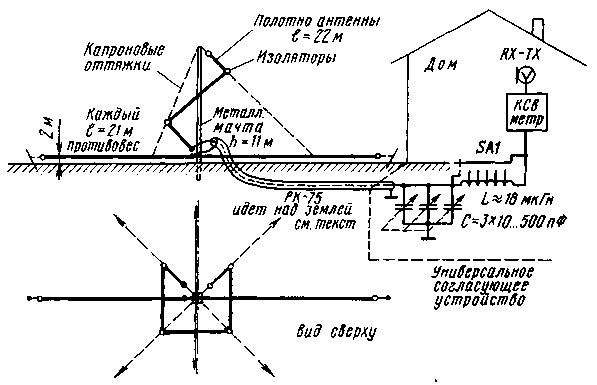
|
|
ENCYCLOPEDIA OF RADIO ELECTRONICS AND ELECTRICAL ENGINEERING Vertical antennas for low frequency bands. Encyclopedia of radio electronics and electrical engineering
Encyclopedia of radio electronics and electrical engineering / VHF antennas Vertical antennas for low-frequency ranges have a significant height, which makes it difficult to install them in amateur conditions. The proposed version of bringing the GP height to acceptable values is not devoid of originality and will help radio amateurs to approach the design of antennas in a new way. The antenna, which will be discussed in this article, is an intermediate option between a full-sized vertical rod and its shortened version - a helical antenna with normal radiation. Here, the term "normal radiation" means that the antenna radiates perpendicular to its axis - like a normal GP (as opposed to helical antennas with axial - along the axis radiation). Such antennas, despite their relatively low efficiency, are widely used in portable VHF radio stations and shortened HF / VHF antennas for mobile communications. The difference from the classic helical GP is that the proposed antenna has only one turn of the helix, which makes it possible to reduce the height of the GP by about half, without noticeably losing efficiency. In practice, it is difficult to make a volumetric spiral for KB ranges, but it can be replaced by a "broken spiral" (Fig. 1).
These ideas were tested on an 80m antenna (Figure 2). The emitter length is 22 meters. Its web is one turn of a "broken spiral" with a winding pitch of 0,1 l and a nominal diameter of 0,04 ... 0,06 l. The antenna and its two counterweights (21 meters each) are made of a self-made cord with a diameter of 2.5 ... 3 mm (several twisted PEVO wires, 5 mm).
The antenna is installed directly at the surface of the earth. Its radiation pattern in the horizontal plane is close to circular. The angle of maximum radiation in the vertical plane is 25". The shape of counterweights isolated from the ground (their length is not less than 0,25 l) can also be curvilinear. In this case, the directivity diagram may change somewhat. The antenna is powered by a 75-ohm cable 11 m long, laid above the ground at a height of about 2 m. To get close to unity SWR, a matching device is connected between the power line and the transmitter. Three-section variable capacitor with an air dielectric - from an old tube radio. Switch - slide type with 15 positions. The coil has 30 turns of PEV-2 wire 1,1 mm wound in 1 mm increments on a frame with a diameter of 45 mm. The coil taps are made every two turns. The same device has been used by me with success for a number of years with various types of antennas on all amateur radio bands. Antenna tuning is carried out by correcting the length of the helical radiator and counterweights, but when using a matching device, this can be omitted. The bandwidth of the antenna with a matching device with an SWR of no worse than 1,9 turned out to be about 60 kHz and no worse than 1,2 - about 30 kHz. When moving through the range in 60 kHz steps and re-tuning the matching device, these parameters are stored in the frequency band from 3500 to 3750 kHz. Antenna efficiency was evaluated in comparison with "Inverted V". The test results showed that on tracks over 1000 km "spiral GP" is more effective than "Inverted V". On routes up to 1000 km there was no difference in the estimates of correspondents. On routes up to 2000 km, the difference was estimated at 0,5-1 points in terms of loudness. At distances of 4000...5000 km the difference was estimated at 1-2 points. And finally, on tracks with a length of 8000 km or more, the difference averaged 2 points or more. Literature
Publication: N. Bolshakov, rf.atnn.ru
A New Way to Control and Manipulate Optical Signals
05.05.2024 Primium Seneca keyboard
05.05.2024 The world's tallest astronomical observatory opened
04.05.2024
▪ Windmills are not a hindrance to birds ▪ 2004 through the eyes of Intel ▪ 48-core Cavium ThunderX processors ▪ Sensors with liquid crystals that change color
▪ section of the site Tools and mechanisms for agriculture. Article selection ▪ article Walking can be slippery on other stones. Popular expression ▪ article Where did Pinocchio come from? Detailed answer ▪ article Removing and installing car wheels. Standard instruction on labor protection ▪ article Radio interference director. Encyclopedia of radio electronics and electrical engineering ▪ article A handkerchief goes from blue to white and vice versa. Focus Secret
Home page | Library | Articles | Website map | Site Reviews www.diagram.com.ua |






 Arabic
Arabic Bengali
Bengali Chinese
Chinese English
English French
French German
German Hebrew
Hebrew Hindi
Hindi Italian
Italian Japanese
Japanese Korean
Korean Malay
Malay Polish
Polish Portuguese
Portuguese Spanish
Spanish Turkish
Turkish Ukrainian
Ukrainian Vietnamese
Vietnamese


 Leave your comment on this article:
Leave your comment on this article: